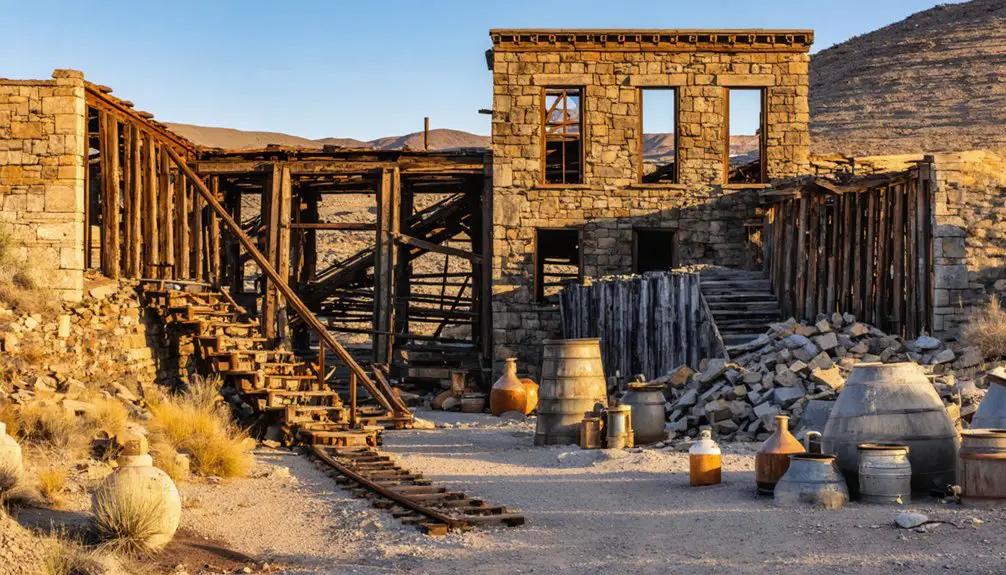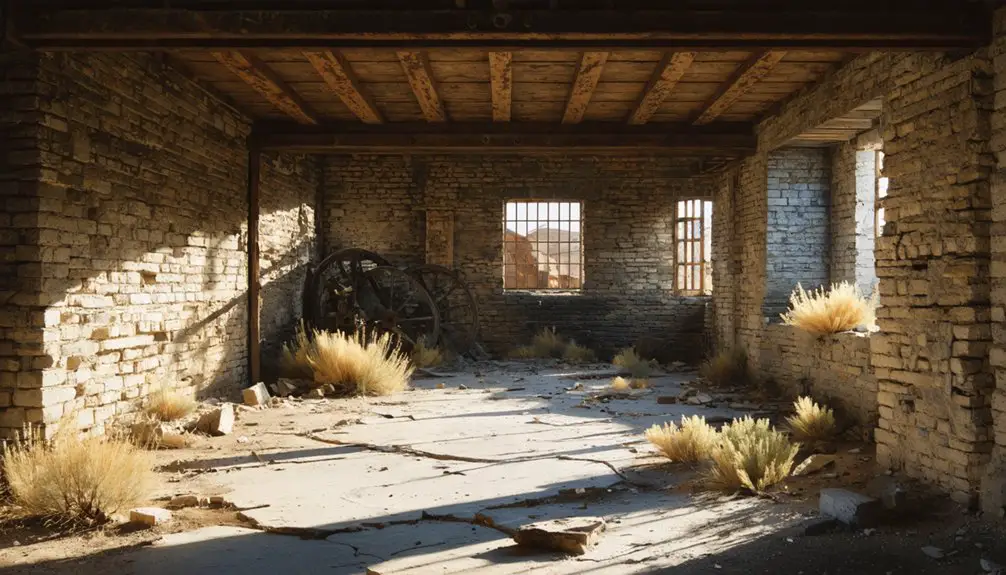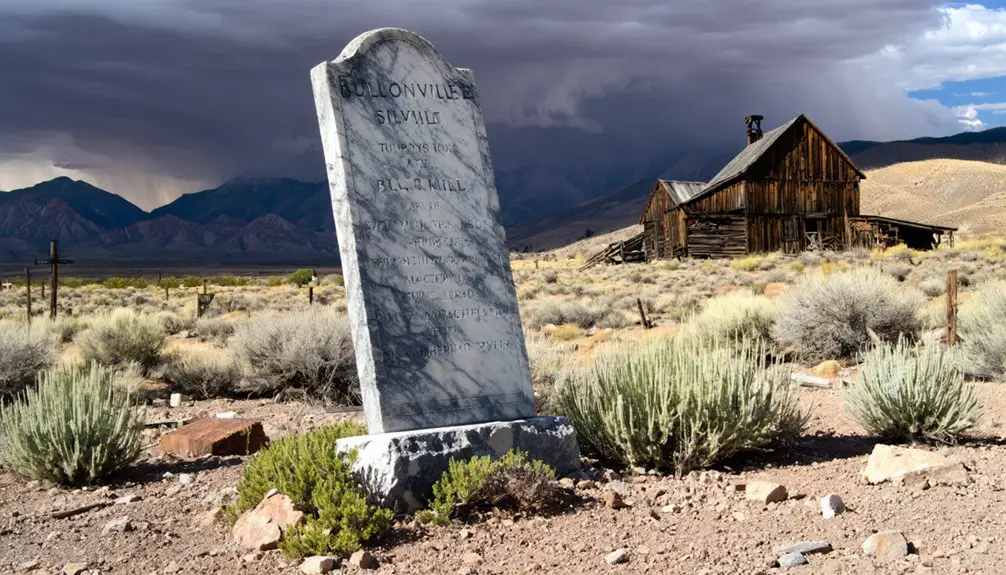You’ll find Bullionville’s ghost town remains along Meadow Valley Creek, where it once served as the primary milling center for Pioche’s silver mines. Established in 1870, the town grew rapidly to 500 residents by 1875, boasting five mills, Nevada’s first narrow-gauge railroad, and essential services. After Pioche built its own waterworks in 1875, Bullionville’s strategic advantage disappeared, leading to its abandonment. The weathered cemetery and industrial remnants tell a deeper story of boom-and-bust mining culture.
Key Takeaways
- Bullionville was established in 1870 as a silver milling center near Pioche, Nevada, reaching its peak population of 500 residents by 1875.
- The town’s strategic location along Meadow Valley Creek made it ideal for processing silver ore from nearby Pioche mines.
- The completion of Pioche’s waterworks in 1875 led to Bullionville’s decline as mills relocated and businesses closed.
- Nevada’s first independent narrow-gauge railroad connected Bullionville to Pioche in 1873, revolutionizing ore transportation before going bankrupt in 1881.
- Today, only the historic cemetery and scattered ruins remain, including evidence of five mills that once processed silver ore.
The Birth of a Milling Town
While many Nevada mining towns sprouted directly around ore deposits, Bullionville emerged in early 1870 as a critical milling center when John H. Ely and W.H. Raymond strategically relocated a five-stamp mill from Hiko to the site.
You’ll find that their choice of location along Meadow Valley Creek proved ingenious, as reliable water access was essential for ore processing mining techniques.
The town’s community dynamics quickly took shape, with 96 residents recorded in the 1870 census. Initially named Ely City, the settlement was renamed Bullionville, reflecting its industrial purpose. By 1875, the town reached its peak with five busy mills operating simultaneously. Like many mining settlements of the era, accessing Bullionville proved challenging due to poor road conditions that persisted throughout its history.
Water Resources and Strategic Location
Because Meadow Valley Creek offered abundant water access, Bullionville’s strategic location proved essential for Nevada’s silver mining industry.
You’ll find this critical water source was the most northerly tributary of the Colorado River in Nevada, providing reliable resources for multiple stamp mills and the region’s first iron foundry.
The town’s geographic advantages included its position just ten miles south of Pioche’s mines and one mile north of Panaca. Mining mill operations only lasted approximately ten years after 1872 before the town’s gradual decline.
Today, visitors can find the historic Bullionville Cemetery half a mile from the visitor center, containing graves dating back to the late 1800s.
The construction of the Pioche and Bullionville Railroad in 1872-1873, a 21-mile narrow gauge line costing $255,000, enhanced the town’s role as a milling hub.
However, when Pioche completed its own waterworks in 1875, Bullionville’s water advantage diminished, redirecting industrial growth back to the mining center.
Railroad Connection to Pioche
You’ll find the Pioche & Bullionville Railroad, constructed in 1872 and operational by 1873, was Nevada’s first independent narrow-gauge railroad that stretched approximately 21 miles between the two communities through Condor Canyon.
This critical transportation link enabled the efficient movement of ore from Pioche’s Treasure Hill mines to Bullionville’s processing facilities, replacing slower wagon routes and mule teams. The railroad ultimately faced financial troubles and went bankrupt in 1881.
The railroad’s impact on local mining economics was significant, as it reduced transport costs and allowed the profitable processing of lower-grade ores that would have been too expensive to move by traditional means. The line transported massive quantities of silver ore worth over $600,000 in 1870 before the railroad was even completed.
Early Rail Infrastructure Development
As silver mining activity intensified around Pioche in the early 1870s, the Pioche & Bullionville Railroad emerged as Nevada’s first independent narrow-gauge railroad, marking an essential development in the region’s transportation infrastructure.
Construction began in 1872, with operations launching in 1873, connecting the silver mines of Pioche to the milling facilities in Bullionville, about a mile north of Panaca. The success of the railroad helped process the incredible over $5 million in ore extracted from the area by 1872. The railroad was later incorporated in 1873 as the Central Nevada Railroad.
The railroad engineering showcased innovative solutions to challenging terrain, including the Burke tunnel that facilitated ore removal to aerial tramways.
Mining logistics improved dramatically as the narrow-gauge design proved ideal for maneuvering the rugged landscape.
You’ll find the line’s route ran through Condor Canyon, efficiently linking mining operations to the Dry Valley milling complex, where ore from the Raymond & Ely and Meadow Valley district claims was processed.
Economic Impact Through Transportation
While the Pioche & Bullionville Railroad operated between 1873 and 1880, it served as a significant economic artery that transformed the region’s mining capabilities.
As Nevada’s second intrastate railroad and first independent narrow-gauge line, you’ll find it revolutionized ore transportation between Pioche’s mines and Bullionville’s mills, spanning roughly 20 miles.
You can trace how this essential transportation network slashed costs compared to wagon shipments, while supporting Bullionville’s growth to 500 residents. The success of this rail system helped establish Pioche as the Lincoln County seat by 1871.
The town’s strategic importance as a milling center stemmed from its reliable water supply, crucial for ore processing. The railroad utilized specialized hopper cars for efficient ore transport.
When Pioche later developed its own milling capacity, Bullionville’s significance waned.
The railroad’s impact on mining efficiency was temporary but profound, setting the stage for future transportation networks like the Jackrabbit Line and Union Pacific connections.
Daily Life in Bullionville’s Heyday
Life in Bullionville during its peak in 1875 centered around a bustling community of 500 residents who relied on the town’s five stamp mills and railroad operations for their livelihood.
The community dynamics reflected a typical frontier settlement, where you’d find mill workers, railroad employees, and various service providers working long hours in challenging desert conditions.
Social interactions revolved around the town’s essential establishments. You could send mail at the post office, shop at local stores, or gather at saloons after work.
Residents found community at local gathering spots, from bustling stores and post offices to lively saloons after their shifts ended.
The blacksmith shop and Nevada’s first iron foundry kept the town’s industrial operations running, while hotels provided lodging for travelers.
Despite the harsh environment and basic living conditions, residents maintained a self-sufficient community until Pioche’s development of independent water and milling facilities led to Bullionville’s eventual decline.
Economic Engine and Industrial Operations

You’ll find that Bullionville’s economic foundation rested on its multiple stamp mills, which processed silver ore from nearby Pioche mines using the reliable water supply from Meadow Valley Creek.
The construction of the Pioche and Bullionville Railroad in 1873 dramatically enhanced the town’s industrial capacity, allowing efficient transport of ore along its 21-mile narrow gauge line that cost $255,000.
The combination of abundant water resources and rail connectivity enabled Bullionville to sustain a population of 500 residents at its peak in 1875, though this prosperity would prove short-lived once Pioche developed its own milling capabilities.
Mill Operations and Scale
Because water access proved essential for industrial processing, Bullionville established itself as the primary milling center for Pioche’s silver mines in early 1870.
The town’s first five-stamp mill, relocated from Hiko by Ely and Raymond, began operations in January of that year, setting the foundation for rapid industrial growth.
Railroad Transport Impact
With the construction of the Pioche and Bullionville Railroad in 1872, Nevada’s first independent narrow-gauge line transformed local industrial operations through a $255,000 investment that revolutionized ore transport.
The railroad’s transportation economics proved game-changing for Bullionville’s development. You’ll find that the 21-mile rail infrastructure slashed ore shipment costs while enabling year-round operations through Condor Canyon. This efficiency attracted five mills by 1875 and supported 500 residents, including Nevada’s first eastern iron foundry.
The rail system’s impact extended beyond simple transport – it created an integrated economic powerhouse. You could see this in the continuous flow of heavy mining equipment, mill supplies, and construction materials that sustained Bullionville’s industrial growth until its eventual decline in the late 1870s.
Water Resource Advantages
While numerous ghost towns dotted Nevada’s landscape, Bullionville’s strategic location along Meadow Valley Creek, a northern tributary of the Colorado River, proved instrumental to its rapid industrial growth.
You’ll find that water management became the town’s defining advantage, enabling the establishment of five mills by 1875 and eastern Nevada’s first iron foundry. The reliable water supply attracted significant investment, supporting a population of 500 residents and creating a thriving industrial hub.
Mill operators maximized milling efficiency by positioning their facilities to utilize gravity-fed water systems, reducing operational costs. The creek’s steady flow sustained continuous ore processing and industrial operations until 1875, when the construction of waterworks in nearby Pioche began drawing industrial activity away from Bullionville.
Notable Buildings and Infrastructure

The mining town of Bullionville once supported substantial infrastructure during its 1870s heyday, though few physical remnants survive today.
Despite its bustling heyday as a mining hub in the 1870s, Bullionville’s once-impressive infrastructure has largely vanished into history.
The Raymond & Eedle five-stamp mill anchored the town’s mining techniques, while railroad construction in 1872 enabled efficient ore transport. At its peak, Bullionville offered crucial community services to roughly 500 residents.
Key infrastructure elements included:
- Industrial facilities featuring stamp mills and waterworks that drew from Meadow Valley Creek
- Commercial establishments including hotels, stores, saloons, and a blacksmith shop
- Transportation networks connecting to larger mining districts, with rail lines serving as essential arteries
Today, only the Bullionville Cemetery and scattered ruins remain accessible, though historic photographs from 1910-1912 document the town’s former industrial glory.
The Impact of the 1875 Decline
The construction of Pioche’s waterworks in 1875 triggered devastating economic ripple effects throughout Bullionville, as the town’s five stamp mills gradually lost their competitive advantage and shut down.
You’ll find that Bullionville’s population, which had peaked at 500 residents that same year, began a swift exodus once the mills relocated to Pioche.
The town’s industrial decline accelerated through 1880 when the last remaining mill closed its doors, effectively ending Bullionville’s role as the region’s primary ore processing center.
Economic Ripple Effects
During Bullionville’s catastrophic economic decline in 1875, Pioche’s completion of waterworks triggered a devastating chain reaction that reshaped the region’s industrial landscape.
As mills relocated to Pioche, Bullionville’s economic diversity crumbled, leading to widespread business closures and transportation challenges that crippled the town’s viability.
The ripple effects devastated the community in three major ways:
- The $255,000 narrow-gauge railroad became obsolete, severing essential transportation links.
- Hotels, saloons, blacksmith shops, and the region’s first iron foundry faced sharp declines in revenue.
- Mass layoffs sparked an exodus of skilled workers, decimating the local tax base and crushing municipal funding.
These cascading losses transformed a once-thriving industrial hub into an unsustainable single-resource economy, ultimately sealing Bullionville’s fate as a ghost town.
Population Exodus Begins
Building upon the economic devastation that gripped Bullionville, 1875 marked a dramatic shift in population dynamics as residents began abandoning their homes en masse.
When Pioche constructed its own water works, you’d have witnessed a swift population migration as workers and their families fled the diminishing opportunities in Bullionville’s once-bustling mill town.
The social disintegration became apparent as the town’s population plummeted from its peak of 500 residents.
You’d have seen stores shuttering, hotels closing, and community bonds fracturing as neighbors departed for more promising locations.
The exodus accelerated through 1880 when the last mill closed, and by 1886, even the post office – a crucial lifeline of communication – ceased operations, leaving behind a shell of what was once a thriving industrial community.
Mills Close Operations
Five operating mills formed Bullionville’s industrial backbone until Pioche’s water works construction in 1875 triggered their systematic shutdown.
The town’s mill technology, once vital for processing Pioche’s ore, became redundant when mines could build their own mills closer to home. You’ll find that these economic shifts devastated Bullionville’s industrial foundation, leading to rapid decline.
- The loss of milling operations eliminated the town’s primary source of employment and revenue.
- Support businesses like blacksmiths and hotels suffered as mill workers departed.
- An 1880 attempt to process tailings couldn’t save the failing economy.
Without its mills, Bullionville’s role as a significant processing center vanished.
You can trace the town’s swift deterioration directly to this loss of industrial purpose, as both workers and businesses sought opportunities elsewhere.
Remnants and Archaeological Significance
Although Bullionville’s original structures have largely vanished, the ghost town’s archaeological legacy endures through several key remnants.
You’ll find the most significant historical marker at the Bullionville Cemetery, which offers invaluable insights into mining demographics and early frontier life. The cemetery’s gravestones reveal migration patterns and mortality rates that characterized Nevada’s mining communities in the late 1800s.
The nearby Panaca Summit Charcoal Kilns stand as evidence to the area’s industrial heritage, while historical photographs housed at the Nevada Historical Society document the town’s mining operations.
Within Cathedral Gorge State Park, you can access these preserved sites that help archaeologists understand the social structures, cultural practices, and occupational challenges faced by mining-era populations.
The site’s location along Meadow Valley Creek explains its strategic importance as a milling center.
Tales From the Cemetery

Standing as a silent tribute to Bullionville’s mining era, the town cemetery reveals compelling stories through its weathered headstones and unmarked graves.
You’ll find evidence of the community’s hardships etched in stone, from industrial accidents to illness that claimed both miners and their families. The cemetery’s historical records and supernatural sightings have made it a focal point for those seeking connections to Nevada’s mining past.
- Historical headstones document the lives of prominent figures like John H. Ely and W.H. Raymond, who established the town’s original mills.
- Local historical hauntings include reports of unexplained shadows and sounds near burial plots at night.
- Archaeological studies from the 1980s have preserved essential information about grave locations and inscriptions, offering insights into 19th-century burial practices.
Legacy in Nevada Mining History
Situated between Pioche and Panaca, Bullionville’s legacy exemplifies how water access shaped Nevada’s 19th-century mining developments.
You’ll find that this ghost town’s story reflects the rapid rise and fall of mining technology in the American West. With its strategic location near Meadow Valley Creek, Bullionville transformed from a modest settlement into an essential milling hub, processing silver ore from nearby Pioche mines.
Bullionville’s creekside location transformed it from humble beginnings into a vital silver processing center for Nevada’s booming Pioche mines.
The town’s innovative narrow-gauge railroad and five operating mills, including eastern Nevada’s first iron foundry, showcase the era’s industrial ambitions.
Yet Bullionville’s fate also demonstrates mining communities’ vulnerability to technological change. When Pioche built its own water system in 1875, the town’s competitive advantage vanished.
Today, Bullionville stands as a reflection of how water resources dictated the success or failure of Nevada’s early mining ventures.
Frequently Asked Questions
What Happened to the Original Mill Equipment After Bullionville Was Abandoned?
You’ll find the mill equipment was salvaged and relocated to other mining sites, with some pieces like the 10-ton mill shipped to Minden in 1925, leaving little for historical preservation.
Were There Any Major Crimes or Lawlessness Reported During Bullionville’s Peak?
You won’t find records of major crimes in Bullionville itself, despite the region’s wild reputation. Crime rates and lawlessness were concentrated in nearby Pioche, while law enforcement issues remained minimal in this milling town.
Did Any Famous Historical Figures Ever Visit or Conduct Business in Bullionville?
Despite serving 17 mills at its peak, you won’t find documented famous visitors or significant historical connections in Bullionville. Only John H. Ely and W.H. Raymond, local mill founders, left their mark.
What Was the Average Wage for Mill Workers in Bullionville?
You can’t determine exact wage comparisons for Bullionville’s mill workers, as historical records are scarce. Labor conditions suggest they likely earned modest daily or weekly wages typical of 1870s mining camps.
Did Native American Tribes Have Any Significant Interactions With Bullionville’s Residents?
You won’t find evidence of significant tribal trade or cultural exchange with Bullionville residents. Native populations were already marginalized by mining activities and had limited documented interactions with the town.
References
- https://nvtami.com/2024/01/17/lincoln-county-ghost-towns/
- https://nvtami.com/2023/11/13/carman-heights-bullionville/
- https://www.nvexpeditions.com/lincoln/bullionville.php
- https://shpo.nv.gov/nevadas-historical-markers/historical-markers/bullionville
- https://www.destination4x4.com/bullionville-nevada-lincoln-county-ghost-town/
- https://www.youtube.com/watch?v=7B9_9RlPi5o
- http://www.onv-dev.duffion.com/articles/bullionville
- https://www.nvexpeditions.com/lincoln/pioche.php
- https://utahrails.net/utahrails/pioche.php
- https://www.nevadaghosttownsandmininghistory.com/portfolio-2/pioche-consolidated-mill



